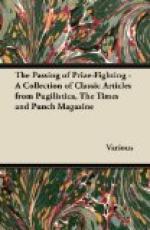That is why I like going down to Kew, where the Spring is tidy and concentrated, and there is a squared map, just like France, at the turnstile gate to direct you to the magnolia dump, and little notices pointing you to the Temperate Houses, though this is really unnecessary, because there are no licensed premises in the Gardens at Kew. All is quiet and calm. You are not even compelled to leave the gravel-walks and tread on the damp grass, unless you have a desire to go to the river’s edge and see how stiffly the tail of the Duke of NORTHUMBERLAND’S stone lion sticks out on the further bank between the two peel towers from which his crossbowmen contemplate the Surrey marshes.
I used to know a man who had mugged up all the trees and plants, so that when you said to him, “What a funny juniper that is over there, with blue peach-blossoms on it,” he would reply, “You mean the Pyrofoliata persica corylus,” and explain how it was first introduced into England by JEREMY TAYLOR in 1658. Then when you went up to look at the placard on the tree you not only found that he was perfectly right, but obtained the additional information that the wood was of a particularly hard and durable nature, and only used for making the heads of croquet mallets and the seats on the tops of motor omnibuses.
I like this plan of putting placards upon trees, and I think it might well be carried out in the country too. There would be none of that standing about in the wet then, and arguing whether the thing is a beech or an oak, when all the time it is a horse-chestnut and laughing up its bark at you.
One must not forget either at Kew the great conservatories, though I do not care for these so much because there are men in them watching to see that you do not pick the cactuses or the palms to put in your button-hole; nor the magnificent Pagoda, which accommodates the Observator, who watches for the flowers to come out, and the Curator, who writes appreciative little notices to stick on the beds; nor the piebald swans in the artificial lake.
But the great glory of Kew is the Pump-room. It is surrounded by marble-topped tables and green seats, and I am aware that it is not called a Pump-room, though a noise proceeds from inside it very like the panting of a pump. They tell me that this is an hydraulic machine for washing up the cups and plates; but I do not believe them, because so many people who take tea round the Pump-room drink left-handed, as if the reverse side of the cup had belonged to somebody else.
Anyhow it is a very jolly and democratic assemblage that sits and drinks tea under the trees and eats cakes that have no placard on them to say at what date they were introduced into England. Here you may see the prosperous docker with his wife and family sitting quite unostentatiously at the next table to the needy scientist who has come to make notes about the purple narcissi. And a little further on is the novelist who is getting local colour for his great rustic love-scene which he is going to say took place in the heart of Devonshire.




